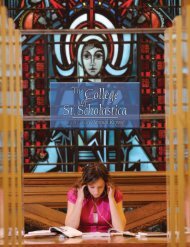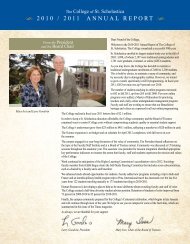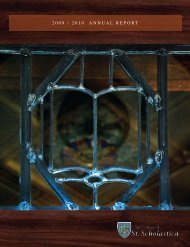by Patrick Flattery, Vice President of Finance - The College of St ...
by Patrick Flattery, Vice President of Finance - The College of St ...
by Patrick Flattery, Vice President of Finance - The College of St ...
You also want an ePaper? Increase the reach of your titles
YUMPU automatically turns print PDFs into web optimized ePapers that Google loves.
2<br />
Beth Domholdt<br />
<strong>Vice</strong> <strong>President</strong> for Academic Affairs<br />
and Dean <strong>of</strong> Faculty<br />
<strong>The</strong> 2005-2006 academic year<br />
was one <strong>of</strong> transition for<br />
Academic Affairs.<br />
I was appointed <strong>Vice</strong> <strong>President</strong><br />
for Academic Affairs in August<br />
2005 and, early in the year,<br />
established six goals based on initial interviews with campus leaders.<br />
<strong>The</strong> goals were to realign structure with function, understand faculty<br />
work, solidify Science Center plans, specify curricular intentions,<br />
streamline assessment, foster a culture <strong>of</strong> scholarship, and reflect on<br />
the Benedictine Wisdom Tradition.<br />
<strong>The</strong>se were placed into the mix <strong>of</strong> goals that had already been<br />
established for the year as part <strong>of</strong> the routine strategic planning process.<br />
Although important progress was made toward all goals, the major<br />
accomplishment <strong>of</strong> the year was the adoption <strong>of</strong> a new academic<br />
structure for implementation in 2006-2007. <strong>The</strong> major<br />
elements <strong>of</strong> the new structure are:<br />
• <strong>The</strong> creation <strong>of</strong> six disciplinary schools headed <strong>by</strong> deans who<br />
are appointed internally based on a school-specific process, with<br />
substantial released time to grow and develop the programs and<br />
faculty within the schools. <strong>The</strong> deans are:<br />
School <strong>of</strong> Arts and Letters, Dean Tammy Ostrander<br />
School <strong>of</strong> Business and Technology, Transition Coordinator<br />
Bob Hartl (a search for a dean to begin in 2006-2007)<br />
School <strong>of</strong> Education, Interim Dean Jo Olsen (search for a<br />
department chair was already underway; will transition to a<br />
search for a dean in 2006-2007)<br />
School <strong>of</strong> Health Sciences, Dean Ron Berkeland<br />
School <strong>of</strong> Nursing, Dean Marty Witrak<br />
School <strong>of</strong> Sciences, Dean Larry McGahey<br />
• <strong>The</strong> creation <strong>of</strong> a formal link between the Accelerated Degree<br />
Evening Program and Academic Affairs <strong>by</strong> establishing the<br />
School <strong>of</strong> Extended <strong>St</strong>udies, with Dean Cathy Carter reporting<br />
jointly to me and the <strong>Vice</strong> <strong>President</strong> for Extended <strong>St</strong>udies and<br />
Market Development.<br />
• Placing authority and responsibility for graduate programs within<br />
the schools, while retaining current curriculum approval functions<br />
and a centralized graduate enrollment management function.<br />
Brian Dalton<br />
<strong>Vice</strong> <strong>President</strong> for Enrollment Management<br />
and Associate Academic Dean for Program<br />
Development<br />
<strong>The</strong> fall <strong>of</strong> 2005 was another<br />
successful year for undergraduate<br />
enrollment management, enrolling<br />
a fourth consecutive record<br />
freshman class, and the sixth<br />
in the last seven years. Over<br />
the past seven years first-year<br />
applications have increased 78 percent (1,471 vs. 826), acceptances<br />
have grown 61 percent (1,279 vs. 796), and entering class enrollment<br />
is up 59 percent (490 vs. 308).<br />
1999 to 2005<br />
Entering Class Enrollment<br />
+59%<br />
1999<br />
308<br />
2005<br />
490<br />
Fall 2005 saw first-year applications increase 10 percent (1,471 vs.<br />
1,338), acceptances grow 10 percent (1,279 vs. 1,167) and first-year<br />
enrollment rise 12 percent (490 vs. 437). Transfer applications were<br />
up 4 percent (428 vs. 411), acceptances were down slightly –<br />
1 percent (320 vs. 323), and transfer enrollment finished down<br />
5 percent (159 vs. 167) following 2004’s record transfer year.<br />
Perhaps most significant <strong>of</strong> all was our ability to maintain the<br />
academic pr<strong>of</strong>ile <strong>of</strong> the <strong>College</strong> while experiencing such phenomenal<br />
growth. As a result, our overall undergraduate full-time population<br />
has risen from 1,150 in 1998 to nearly 1,900 students in fall 2005, a<br />
65 percent increase in full time students.<br />
In a continuation <strong>of</strong> the trend begun over the past couple years,<br />
we are attracting significantly more students from the Twin Cities<br />
and southern Minnesota – 58 percent <strong>of</strong> the entering class – while<br />
maintaining our draw <strong>of</strong> students from the Iron Range in spite <strong>of</strong><br />
demographic decline there.<br />
<strong>St</strong>udents from Duluth and the surrounding area are enrolling<br />
at record rates even though the number <strong>of</strong> high school graduates<br />
is declining – a trend that shows that our message <strong>of</strong> quality is<br />
reverberating in our own back yard.<br />
Finally, our draw <strong>of</strong> diversity to the Duluth campus is ever increasing.<br />
Domestic students <strong>of</strong> color and international students now represent<br />
10 percent <strong>of</strong> the total undergraduate population. <strong>St</strong>udents from 23<br />
countries now call <strong>St</strong>. Scholastica home.








